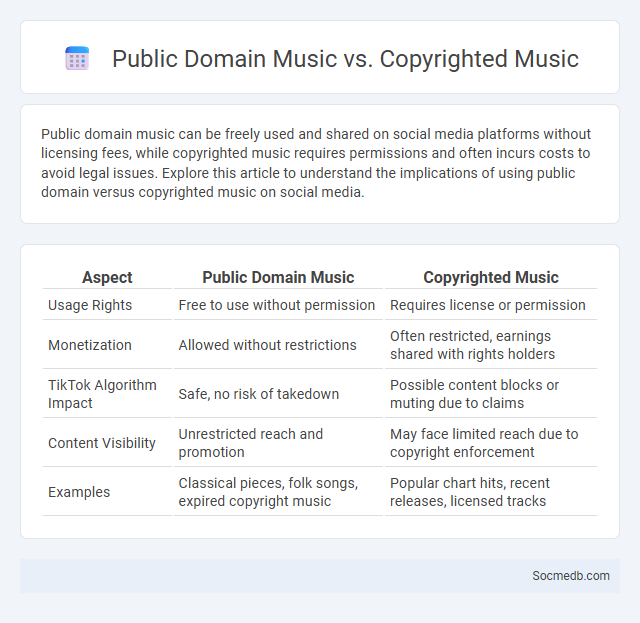
Photo illustration: Public Domain Music vs Copyrighted Music
Public domain music can be freely used and shared on social media platforms without licensing fees, while copyrighted music requires permissions and often incurs costs to avoid legal issues. Explore this article to understand the implications of using public domain versus copyrighted music on social media.
Table of Comparison
| Aspect | Public Domain Music | Copyrighted Music |
|---|---|---|
| Usage Rights | Free to use without permission | Requires license or permission |
| Monetization | Allowed without restrictions | Often restricted, earnings shared with rights holders |
| TikTok Algorithm Impact | Safe, no risk of takedown | Possible content blocks or muting due to claims |
| Content Visibility | Unrestricted reach and promotion | May face limited reach due to copyright enforcement |
| Examples | Classical pieces, folk songs, expired copyright music | Popular chart hits, recent releases, licensed tracks |
Introduction to Music Copyright Concepts
Music copyright protects original compositions and sound recordings, granting creators exclusive rights to reproduce, distribute, and perform their work. Social media platforms facilitate the rapid sharing of music, but unauthorized use can lead to infringement claims and content removal. Understanding music copyright is essential for users and creators to navigate legal boundaries and monetize their content effectively.
What is Public Domain Music?
Public domain music consists of musical works whose copyrights have expired, been forfeited, or never applied, allowing free and legal use by anyone. You can incorporate public domain music into your social media content without worrying about licensing fees or copyright infringement claims. This includes classical compositions, traditional folk songs, and recordings released before copyright protections were established.
Defining Copyrighted Music
Copyrighted music refers to audio compositions and recordings protected under intellectual property laws, granting creators exclusive rights to reproduce, distribute, and publicly perform their work. On social media platforms, unauthorized use of such music can lead to content removal, account strikes, or legal penalties due to infringement claims. Platforms utilize automated content identification systems like Content ID on YouTube and Rights Manager on Facebook to enforce these protections and ensure rightful owners receive royalties.
Understanding Sound Copyright (Neighboring Rights)
Understanding sound copyright under neighboring rights is essential for managing the use of recorded music on social media platforms, as these rights protect performers, producers, and broadcasters involved in the creation and transmission of sound recordings. Social media algorithms continuously monitor content to ensure compliance with copyright laws, triggering automated copyright claims or removals when unauthorized use of protected audio occurs. Platforms like YouTube, Instagram, and TikTok implement licensing agreements to balance user creativity with the legal rights of sound recording stakeholders, emphasizing the need for knowledge of neighboring rights for content creators.
Key Differences: Public Domain vs Copyrighted Music
Social media platforms differentiate sharply between public domain and copyrighted music in terms of usage rights. Public domain music is free for You to use without seeking permission or paying fees, while copyrighted music requires licenses to avoid restrictions or content removal. Understanding these key differences ensures Your social media content remains compliant and accessible to a wider audience.
Benefits and Limitations of Using Public Domain Music
Using public domain music on social media offers benefits such as cost savings, legal safety, and greater creative freedom, allowing content creators to avoid copyright claims and monetize their work without restrictions. However, limitations include a narrower selection of tracks compared to licensed music libraries, potential lower audio quality, and the absence of exclusivity, which can reduce originality and audience engagement. Strategic use of public domain music enhances content accessibility but requires careful curation to maintain audience interest and platform compliance.
Legal Implications of Using Copyrighted Music
Using copyrighted music on social media without proper authorization can result in legal consequences including content removal, account suspension, and potential lawsuits. Platforms like YouTube and Instagram employ automated systems to detect and flag unauthorized use, enforcing copyright laws to protect artists and rights holders. To safeguard your account and comply with legal standards, ensure you obtain licenses or use royalty-free music for your social media content.
How Sound Copyright Differs from Music Copyright
Sound copyright protects the specific recording of a performance, including the producer's rights over the audio captured in that session. Music copyright covers the composition itself, such as the melody, lyrics, and arrangement created by songwriters and composers. Understanding these differences helps you navigate legal use of both recordings and compositions on social media platforms.
Licensing and Usage: What You Need to Know
Understanding social media licensing and usage rights is crucial for content creators and marketers to avoid copyright infringements. Most platforms grant non-exclusive licenses to use, reproduce, and distribute user content but retain ownership with the creator. Always review platform-specific terms and obtain explicit permissions for commercial use to ensure compliance and protect intellectual property.
Choosing the Right Music for Your Project
Selecting the right music for your project on social media significantly influences audience engagement and emotional response. Understanding the target demographic's preferences, platform trends, and copyright regulations ensures your content remains captivating and compliant. You can amplify your message by syncing visuals with music that enhances the storytelling and brand identity.
 socmedb.com
socmedb.com